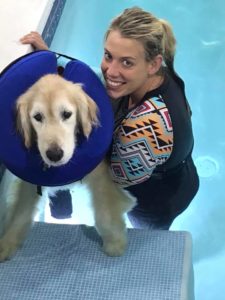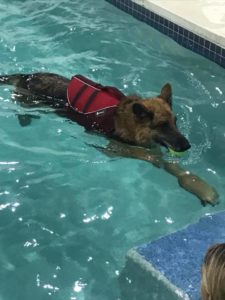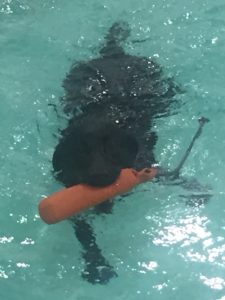Doctors and physical therapists often recommend swimming as a low-impact exercise for people recovering from injuries or as a way for older individuals to stay active. Swimming is said to be easy on our joints, while building up endurance and muscle strength. In fact, you work almost every muscle in your body when you swim, making it a wonderful workout. But, does swimming provide similar benefits for dogs? According to Dr. Stephanie Liff, a practicing veterinarian and owner of Pure Paws Veterinary Care in Brooklyn, N.Y., the answer is yes.
“Just like for people, swimming is a low-impact form of exercise that can be very useful to pets,” says Dr. Liff. “It can help with healing and rehabilitation post-orthopedic or neurological surgery, or can be used for weight loss in pets that have arthritis or other limitations that make exercise difficult.”
Almost any dog can benefit from the exercise swimming provides, but Dr. Liff says it’s especially useful for senior canines or younger pets with disabilities.
It’s important to note that if your dog is healing from an injury or illness, you should definitely check with your vet to make sure it’s safe for him to swim. “There is an appropriate time postoperatively to start swimming, which is after all wounds and incisions have healed, and the sutures or staples are removed,” Dr. Liff explains. And in some cases, swimming might not be the best option. “Many pets with a dermatologic disease should avoid public water sources, or in some cases, should not be exposed to swimming due to open sores, etc.,” she adds. “Also, dogs with ear infections should not swim while being treated.”
For dogs that get the go-ahead to swim, make sure they don’t overdo it. Some canine companions don’t know when to stop. Dr. Liff says it’s important to start slowly and watch your dog for signs of overexertion. “Just like with any exercise, it is important to consult your veterinarian before starting a new program,” she advises. “Also, since it is exercise and can lead to muscle exertion, you can see soreness after swimming, so monitor your pet and adjust the duration of the exercise as needed.”
Depending on where you live, you may have several choices when it comes to where your dog swims: creeks, lakes, the ocean, a dog swim center, or even your own backyard pool. All of these vary in depth, strength, temperature, and, of course, water quality. There’s always a chance with public bodies of water that your dog could pick up an infection, such as giardia (an intestinal infection that spreads through contaminated food or water). If your dog has a compromised immune system, it might be best to avoid letting him swim in public bodies of water. “In terms of therapy, the location does not matter, but, of course, safety is maximized by a controlled environment, which the river or ocean may not provide, depending on other factors,” Dr. Liff explains.
If your dog goes swimming in a pool, make sure there is an easy way for him to get out, such as stairs, to prevent possible drowning. If there’s a risk that your pup could venture into deeper water, like in an ocean or lake, have him wear a dog life jacket.
Keep in mind that all dogs are not natural swimmers, and some really do not like water, so introduce your canine companion to swimming slowly and safely to avoid accidents. Dr. Liff cautions that no dog should swim without a human closely observing him.
From American Kennel Club
Writer: Kristina Lotz









